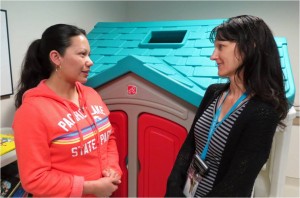
A patient arrived at Seattle Children’s Emergency Department by helicopter, alone and unconscious. As the Emergency Department team worked to resuscitate the boy who had nearly drowned, his parents drove several hours in stunned silence to the hospital, hoping their son would be alive when they got there. After receiving the good news that he would ultimately recover from the accident, they realized that they’d left their cell phone charger at home and had no way to contact family and friends.
It’s a common scenario for families, who often arrive at Seattle Children’s Hospital for lifesaving care with little more than the clothes on their backs.That’s where the Patient Emergency Assistance Fund, administered by Seattle Children’s Social Work Department, comes into play. The fund provides short-term help to families who are hours away from home with little money and few of the basic necessities of life.
Social worker Lynne Hakim calls the fund a safety net and says the basic necessities it purchases, like a simple cell phone charger, can be the bridge that helps a family cope with all the uncertainty and intensity inherent in an unplanned hospital stay.
Though the need exceeds the fund’s ability to offer support to all families who come to the hospital in trauma, it does provide immediate necessities to more than 1,600 families each year. Last year, Seattle Children’s social workers spent 30 percent of the fund on food vouchers, gas cards and transportation assistance.
“Our first priority is helping families who are most in need when they arrive,” explains Roosevelt Travis, director of Social Work at Seattle Children’s. “Whether they need a cab or a phone card, the fund can provide those basics while they line up their own resources; and it also buys our social workers time to connect families with the appropriate social services outside the hospital if a longer term solution is required.”
The burden of hospitalization
Half of the calls after-hours social worker Yasha Carpentier gets are for everyday needs like a meal or a change of clothes. Occasionally, she uses the fund to help families with larger expenses, liking covering the costs of a child’s funeral.
Most requests come from nurses and doctors, but sometimes families learn about the fund through other parents or ask Carpentier directly if help is available.
“A child’s hospitalization is a financial burden for most anyone,” she explains. “We estimate that one-third of our families spend every dollar they make on living expenses. There’s no safety net if one or both parents have to miss a paycheck to be with a sick or injured child. For this group of parents and caregivers, the cost of seeing to their own basic needs — especially buying food — is probably the biggest financial strain during their child’s hospital stay.”
A call from a nurse who hasn’t seen a parent eat anything for a few days is one of the most heartbreaking calls Carpentier receives.
“You shouldn’t have to worry about going hungry because your child is in a hospital bed,” she says. “If we can eliminate just that one stressor for even a few days, it greatly improves the parent’s ability to be present for their child. They are always so appreciative.”
True emergency assistance…and more
The fund also helps families with other basic needs like housing.
For example, after a young boy was hospitalized for two weeks, the loss of income from mom’s small business and dad’s unpaid leave tapped their scant resources and left them unable to pay their rent. Their social worker negotiated with the family’s landlord to waive late fees and then tapped into the emergency fund to pay part of the family’s monthly rent and travel costs back to their hometown to ensure the family wouldn’t be homeless upon their son’s discharge.
“The fund offers a ray of hope when time in the hospital saps all of a family’s resources,” Travis explains.
Another example of the fund’s use includes helping a family buy two twin beds for their chronically ill children after the deposit and rent on a new apartment left them unable to purchase furniture. Resources from the fund were also used to turn the utilities back on in the home of a single mom, who had spent months at the hospital with her son. Having working utilities in the home was not only a requirement prior to the boy’s discharge, but also critical in ensuring that he would have the best chance of staying healthy after his long hospital stay.
“If you’ve ever had an emergency where someone came to your aid, then you know the flood of relief that our families feel,” says Travis. “For all the families at Seattle Children’s who have been helped by this fund once or those who’ve used it repeatedly, it always makes a big difference in their quality of life and the level of support they’re able to give their child. We’re grateful every day to the donors who make this resource possible.”
If you’d like to donate to the fund, please visit our donate page and specify that you want your gift to go to the Patient Emergency Assistance Fund. And if you’re a fan of glassybaby, you can also help by purchasing a “hope” glassybaby because 10 percent of “hope” sales is donated to Seattle Children’s Patient Emergency Assistance Fund.

